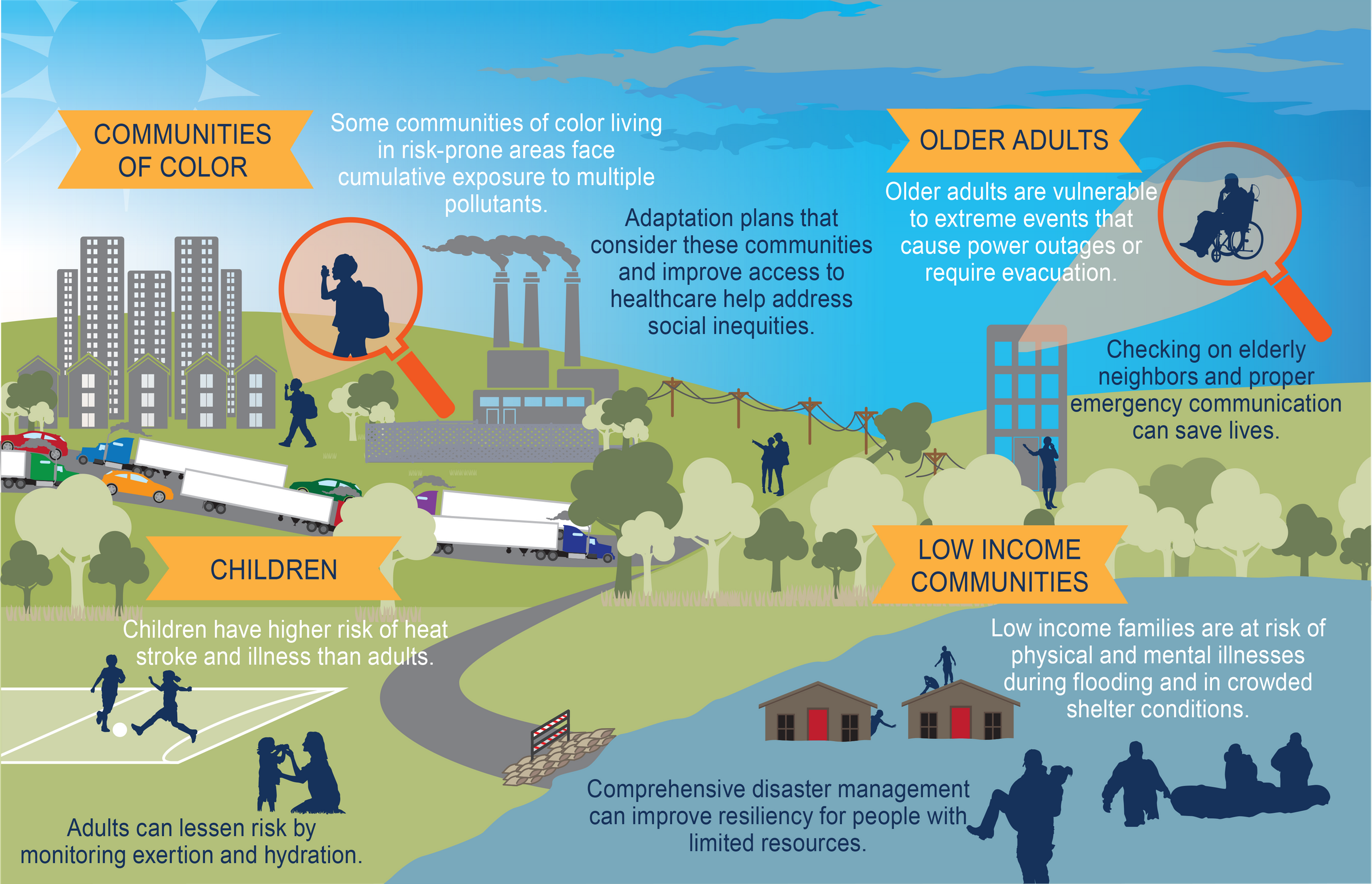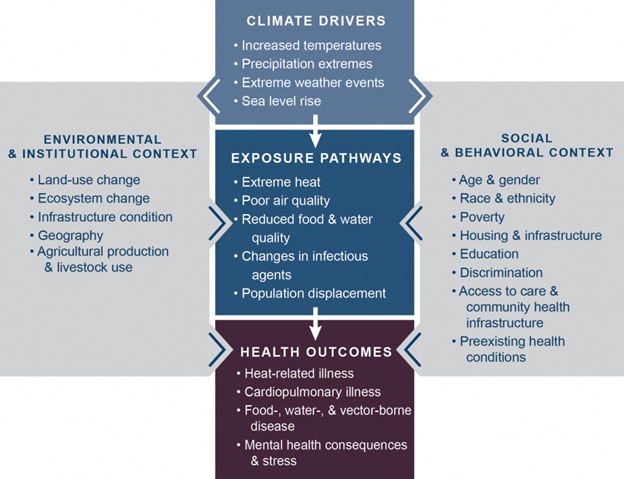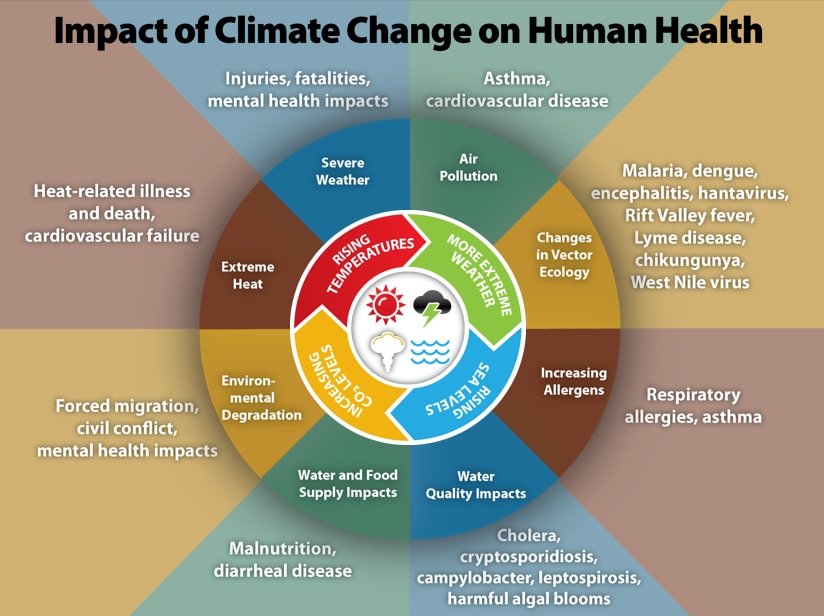Climate change poses current and increasing threats to human health. As the climate continues to warm, the risks to human health will grow, exacerbating existing health threats and creating new public health challenges. HHS is committed to taking actions across the whole department to protect the health and wellbeing of all people, especially those most vulnerable.

Read a description of this image
Examples of populations at higher risk of exposure to adverse climate-related health threats are shown along with adaptation measures that can help address disproportionate impacts. When considering the full range of threats from climate change as well as other environmental exposures, these groups are among the most exposed, most sensitive, and have the least individual and community resources to prepare for and respond to health threats. White text indicates the risks faced by those communities, while dark text indicates actions that can be taken to reduce those risks.
Many disadvantaged communities currently bear the brunt of climate-induced health risks from extreme heat, poor air quality, flooding, extreme weather events, and vector borne diseases.
There are many factors that can affect someone’s ability to prepare for, respond to, and cope with the impacts of climate change on health. These include:
- Living in areas particularly vulnerable to climate change (like communities along the coast or extreme weather)
- Coping with higher levels of existing health risks when compared to other groups
- Living in low-income communities with limited access to healthcare services
- Limited access to quality healthcare
- Limited availability of information and resources in a person’s native language
- Limited ability to relocate or rebuild after a disaster
The effects of climate change can worsen existing differences in health, adding to other longstanding differences among people that result in different health outcomes for communities in the United States. These differences include poor living conditions, racism and other forms of discrimination, and psychological stresses.

Source: The Impacts of Climate Change on Human Health in the United States: A Scientific Assessment
Read a description of the graphic
This figure shows how climate change affects human health. Climate change is increasing temperatures, causing sea level to rise, and increasing the strength of storms and the risks of both flooding and drought. These changes in turn lead to people being exposed to different threats to their health, including extreme heat, contaminated food or water, poor air quality, and changes in the distribution or infectivity of disease-causing insects. These different exposure pathways are influenced by other factors that interact to affect health outcomes (gray side boxes). Key factors that influence vulnerability for individuals are shown in the right box and include social determinants of health and behavioral choices. Key factors that influence vulnerability at larger scales, such as natural and built environments, governance and management, and institutions, are shown in the left box. All of these influencing factors can affect the vulnerability of an individual or a community through changes in exposure, sensitivity, or adaptive capacity.
How climate change impacts human health
Climate change is already increasing the severity or frequency of health threats occurring in some areas. In other areas, climate change affect on land, water, and air quality can cause new health problems where they hadn't previously occurred.
- Heat: More frequent and severe heat waves lead to more heat-related illnesses and deaths.
- Seasonal Changes: Seasonal changes can shift the geographic area where disease-carrying insects, such as mosquitoes, ticks, and fleas transmit West Nile Virus, dengue fever, Lyme disease, and malaria to humans.
- Air Quality: Increasing exposure to pollen due to increased plant growing seasons, to molds due to severe storms, and to air pollution due to increased temperature and wildfires, can all worsen lung diseases, such as asthma.
- Temperature Changes: Increasing temperatures can cause poor air quality that affects the heart and worsens cardiovascular disease.
- Flooding: Flooding events can contaminate water with harmful bacteria, viruses, and chemicals that cause foodborne and waterborne illnesses.
- Severe Weather: In addition to injuries, illnesses, and deaths, more frequent and severe extreme weather events can harm mental health due to damage to property, loss of loved ones, displacement, and chronic stress.
- Health Care System Impacts
Extreme climate events can place added stress on hospital and public health systems and limit people's ability to obtain adequate health care during crises
Learn about the threats of climate change on human health. Explore by topic and region.

Read a description of the graphic
Four major environmental impacts that will impact human health include: Rising Temperatures, More Extreme Weather, Rising Sea Levels, and Increased Greenhouse Gas Levels.
This will have many health impacts such as:
- Extreme heat which leads to heat-related illness, cardiovascular failure, and death
- Severe weather which leads to injuries, fatalities, and mental health impacts
- Air pollution which leads to asthma and cardiovascular disease
- Changes in vector ecology which lead to malaria, dengue, encephalitis, hantavirus, Rift Valley fever, Lyme disease, chikungunya, West Nile virus
- Increasing allergens which leads to respiratory allergies and asthma
- Water quality impacts which lead to cholera, cryptosporidiosis, campylobacter, leptospirosis, harmful algal blooms
- Water and food supply impacts which lead to malnutrition and diarrheal disease
- Environmental degradation which leads to forced migration, civil conflict, and mental health impacts
Actions we're taking
Learn how the OCCHE is working across HHS and with other agencies to address climate change to ensure health equity
Meet our team
Learn who is leading HHS climate change and health equity work

